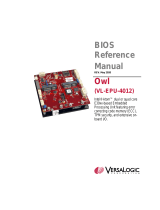
v
Contents
3.3.3 Legacy Diskette A ........................................................ 3-12
3.3.4 Language ...................................................................... 3-12
3.3.5 SATA 1–6 ...................................................................... 3-13
3.3.6 Storage Conguration ................................................... 3-14
3.3.7 AHCI Conguration ....................................................... 3-15
3.3.8 System Information ....................................................... 3-16
3.4 Ai Tweaker menu ........................................................................ 3-17
3.4.1 Congure System performance Settings ...................... 3-17
3.5 Advanced menu ......................................................................... 3-24
3.5.1 CPU Conguration ........................................................ 3-24
3.5.2 Chipset .......................................................................... 3-26
3.5.3 Onboard Devices Conguration .................................... 3-28
3.5.4 USB Conguration ........................................................ 3-30
3.5.5 PCIPnP ......................................................................... 3-31
3.6 Power menu ................................................................................ 3-32
3.6.1 Suspend Mode .............................................................. 3-32
3.6.2 Repost Video on S3 Resume ........................................ 3-32
3.6.3 ACPI 2.0 Support .......................................................... 3-32
3.6.4 ACPI APIC Support ....................................................... 3-32
3.6.5 APM Conguration ........................................................ 3-33
3.6.6 Hardware Monitor ......................................................... 3-34
3.7 Boot menu .................................................................................. 3-36
3.7.1 Boot Device Priority ...................................................... 3-36
3.7.2 Boot Settings Conguration .......................................... 3-37
3.7.3 Security ......................................................................... 3-38
3.8 Tools menu ................................................................................. 3-40
3.8.1 ASUS EZ Flash 2 .......................................................... 3-40
3.8.2 Express Gate ................................................................ 3-41
3.8.3 ASUS O.C. Prole ......................................................... 3-42
3.8.4 AI Net 2 ......................................................................... 3-43
3.9 Exit menu .................................................................................... 3-44
Chapter 4: Software support
4.1 Installing an operating system ................................................... 4-1
4.2 Support DVD information ............................................................ 4-1
4.2.1 Running the support DVD ............................................... 4-1




















